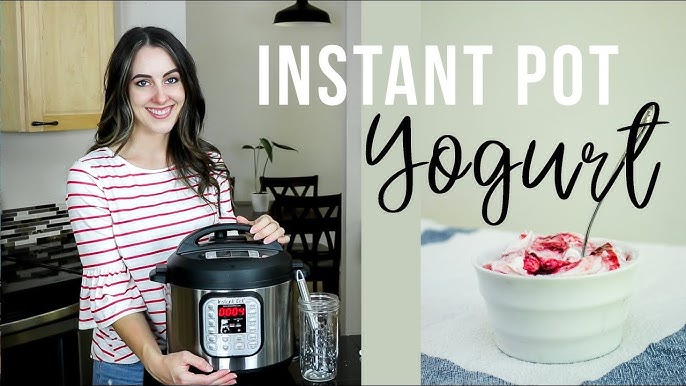Instant Pot Yogurt Recipe: Have you ever craved thick, creamy yogurt made right in your kitchen without the mystery additives or a trip to the store? Making yogurt at home used to feel like a task for the culinary elite. But thanks to the Instant Pot, it’s now ridiculously easy—and dare we say, kind of fun.
This step-by-step guide will walk you through how to make perfect homemade yogurt in your Instant Pot, from prepping to setting to spooning up your first batch.
Why Make Yogurt at Home?
Let’s be real—store-bought yogurt has its perks. It’s convenient, it comes in ten thousand flavors, and it’s practically in every fridge in America. But here’s the thing: it’s often loaded with added sugars, preservatives, and sometimes even artificial thickeners. When you make your own yogurt at home, you control every ingredient that goes into it.
Besides, homemade yogurt is cheaper in the long run. A single gallon of milk can yield about a half-gallon of yogurt, which is a great deal when you think about how much premium Greek yogurt costs. And then there’s the satisfaction—because there’s something deeply satisfying about cracking open your own jar of silky, tangy yogurt that you made with your own hands.
Benefits of Using an Instant Pot
The Instant Pot has become a kitchen superstar—and for good reason. Among its many talents is the “Yogurt” function, designed specifically to make this process effortless. No more guesswork. No worrying about holding milk at just the right temperature for hours. The Instant Pot does it all.
It keeps the milk at a precise temperature for fermentation, which is critical to making yogurt that’s safe and tasty. It also saves time and minimizes mess. Forget the stove and thermometer routine; you’ve got a one-pot yogurt machine right on your countertop.
What You Need to Get Started
Ingredients Required
Don’t worry—you won’t need an exotic ingredient list for this. Here’s what you need to make plain Instant Pot yogurt:
- Milk (Whole milk preferred) – 1 gallon
- Yogurt starter (with live active cultures) – 2 to 3 tablespoons
- Optional: Sweetener (honey, sugar, or maple syrup) – if you want it sweet
- Optional: Vanilla extract – for flavor
The fresher the milk, the better the taste. Whole milk gives you creamier results, but you can experiment with 2% or skim if you’re watching fat content. Just know the texture may be slightly thinner.
For the starter, you can use any plain yogurt from the store—as long as it has live active cultures. Once you make your first batch, save a few tablespoons of it to use as a starter for your next batch. It’s a yogurt loop!
Recommended Tools and Equipment
Having the right tools makes the process a breeze. Here’s what you’ll need:
- Instant Pot with a Yogurt Function – this is non-negotiable
- Whisk or Spoon – for mixing
- Measuring Cup – to portion your starter
- Thermometer (optional but helpful) – to check milk temperature
- Glass jars or containers – to store the finished yogurt
- Strainer or cheesecloth (optional) – if you want thicker, Greek-style yogurt
Once you’ve gathered everything, you’re ready to move on to the magic part—making the yogurt!
Step-by-Step Guide to Making Instant Pot Yogurt
Step 1: Prepare Your Ingredients and Equipment
First things first—clean everything. Yogurt is a live culture, which means it’s sensitive to contaminants. Wash your Instant Pot liner, whisk, and containers with hot, soapy water to avoid introducing unwanted bacteria.
Then, pour the milk into your Instant Pot inner pot. You can use a full gallon, or half if you’re doing a smaller batch. Make sure the sealing ring is removed or clean—though you don’t need to seal the Instant Pot for yogurt-making.
Step 2: Heat the Milk
Now hit the “Yogurt” button until it reads “Boil.” This doesn’t mean it will boil the milk like water—it brings it to about 180°F (82°C), which is necessary to denature the proteins in the milk. This helps the yogurt thicken properly.
This step usually takes 30 to 45 minutes, depending on your Instant Pot model and the amount of milk. When it beeps and displays “Yogt” or switches off, lift the lid and use a thermometer to confirm the milk has reached the desired temperature.
Step 3: Cool the Milk
Once the milk is heated, it needs to cool down to around 110°F (43°C) before you add your starter. Why? Too-hot milk will kill the live cultures. Let the inner pot sit on the counter to cool naturally for about 30 to 45 minutes. You can speed this up by placing the pot in a cold water bath in your sink.
Keep checking the temperature—110°F is the magic number. Don’t skip this step!
Step 4: Add the Starter Yogurt
Now that your milk has cooled to the ideal temperature, it’s time to introduce the live cultures that will transform it into yogurt.
Tempering the Starter:
To ensure a smooth blend and prevent any lumps, it’s best to temper the starter yogurt. Here’s how:
- Scoop a Portion of Warm Milk: Take about a cup of the cooled milk and place it in a separate bowl.
- Add the Starter Yogurt: Introduce 2 to 3 tablespoons of plain yogurt with live active cultures into the bowl.
- Whisk Until Smooth: Mix the yogurt and milk until you achieve a uniform consistency.
- Combine with the Rest of the Milk: Pour this tempered mixture back into the main pot of cooled milk and stir thoroughly to distribute the cultures evenly.
Choosing the Right Starter:
- Store-Bought Yogurt: Ensure it’s plain and lists live active cultures on the label.
- Previous Batch: You can use yogurt from a previous homemade batch, but it’s advisable to refresh your starter every few batches to maintain potency.
Tips:
- Avoid flavored or sweetened yogurts as starters; they can interfere with the fermentation process.
- Ensure all utensils and containers are clean to prevent unwanted bacteria from affecting your yogurt.
Step 5: Incubate the Yogurt
With the cultures introduced, the next phase is incubation, where the magic of fermentation happens.
Using the Instant Pot:
- Return the Inner Pot: Place the inner pot back into the Instant Pot housing.
- Secure the Lid: You can use the regular lid or a glass lid. Sealing isn’t necessary as pressure isn’t used in this process.
- Select the Yogurt Setting: Press the “Yogurt” button. Adjust the time based on your preference:
- 8 Hours: Mild flavor and thinner consistency.
- 10 Hours: Balanced tang and thickness.
- 12 Hours: Tangier taste and thicker texture.
- Monitor the Process: The Instant Pot will maintain a steady temperature, ideal for bacterial growth. Avoid disturbing the pot during this time.
Post-Incubation:
- Check Consistency: The yogurt should have a custard-like texture and a pleasant aroma.
- Taste Test: If it’s too mild, you can incubate for a couple more hours in the next batch for a tangier flavor.
Note: Longer incubation times result in tangier yogurt due to increased lactic acid production.
Step 6: Chill and Set the Yogurt
After incubation, it’s essential to cool the yogurt to halt fermentation and set its texture.
Cooling Process:
- Remove the Inner Pot: Carefully take out the inner pot from the Instant Pot.
- Cover: Place a clean lid or plastic wrap over the pot to prevent skin formation.
- Refrigerate: Let the yogurt chill in the refrigerator for at least 4 hours. This helps it firm up and enhances the flavor.
Optional – Straining for Greek Yogurt:
If you prefer thicker, Greek-style yogurt:
- Prepare a Strainer: Line a fine-mesh strainer with cheesecloth or a clean kitchen towel.
- Place Over a Bowl: Ensure the bowl is large enough to catch the whey.
- Transfer Yogurt: Gently pour the yogurt into the lined strainer.
- Refrigerate: Let it strain in the fridge for 2 to 6 hours, depending on desired thickness.
- Collect Whey: The liquid whey can be saved and used in smoothies, baking, or as a protein-rich addition to various dishes.
Final Steps:
- Transfer to Containers: Once set (and strained, if desired), spoon the yogurt into clean jars or containers.
- Label and Date: It’s helpful to note the date of preparation for freshness tracking.
- Store: Keep the yogurt refrigerated and consume within 10 to 14 days.
Tips for Perfect Instant Pot Yogurt
Troubleshooting Common Issues
Even with a user-friendly gadget like the Instant Pot, things can occasionally go awry. Here’s how to handle the most common hiccups:
1. Yogurt Didn’t Set: This is the most frequent issue. The result may be runny, like milk with a slight tang. Causes include:
- Starter Not Active: Make sure your starter yogurt contains live active cultures.
- Temperature Was Too Hot: If you added the starter while the milk was still too warm, the cultures may have died.
- Not Enough Incubation Time: Yogurt needs adequate time to ferment. If it’s too cool or rushed, it won’t develop properly.
2. Yogurt Is Lumpy or Grainy: This usually means the milk wasn’t whisked thoroughly, or the cultures weren’t evenly distributed. Whisking during the cooling and mixing phases helps prevent this.
3. Yogurt Tastes Sour or Bitter: Too long of an incubation time can make yogurt taste overly tangy. Stick to 8–10 hours for a milder flavor, especially if you’re not straining it.
4. A Watery Layer on Top: This is whey and completely normal. You can stir it back in or strain it out for thicker yogurt.
Tips to Prevent Problems:
- Always clean your pot and tools thoroughly before starting.
- Use a thermometer if you’re unsure of temperature.
- Don’t disturb the yogurt during incubation—it needs to sit still to form a proper set.
Flavor Variations and Add-ins
Plain yogurt is versatile, but you can also get creative by adding delicious flavors and textures.
Flavor Ideas (Add After Incubation):
- Vanilla: Stir in 1–2 teaspoons of pure vanilla extract.
- Sweeteners: Add honey, maple syrup, or agave to taste.
- Fruits: Blend in berries, peaches, mangoes, or bananas for fruity yogurt.
- Spices: Cinnamon, nutmeg, or cardamom can add warmth and depth.
Savory Variations:
- Garlic and Cucumber: Perfect for tzatziki.
- Dill and Lemon Zest: Makes a zesty yogurt dip.
Granola or Nuts:
- Mix in almonds, walnuts, or granola just before serving for a satisfying crunch.
When to Add Extras:
Always wait until after the yogurt has been incubated and cooled before adding anything. Add-ins can interfere with fermentation if introduced too early.
Pro tip: Make your yogurt plain, then portion it out and flavor individual servings. That way, you can have variety without compromising the base yogurt.
Storing and Serving Homemade Yogurt
How to Store Yogurt Properly
Proper storage ensures your yogurt stays fresh and safe to eat.
Best Practices:
- Refrigerate Immediately: As soon as your yogurt is done setting, transfer it to the fridge.
- Use Airtight Containers: Glass jars, Mason jars, or BPA-free plastic containers work well.
- Avoid Cross-Contamination: Use a clean spoon every time you scoop yogurt.
Shelf Life:
- Homemade yogurt lasts 10–14 days in the fridge.
- The flavor will intensify slightly over time.
- If it develops a sour smell, mold, or unusual texture, discard it.
Freezing Yogurt:
- You can freeze yogurt in small batches, especially if you want to preserve starter for future use.
- Frozen yogurt may separate when thawed, so it’s better used in smoothies or baking.
Creative Ways to Serve Homemade Yogurt
Homemade yogurt is not just a breakfast staple—it can be a key ingredient in a variety of meals and snacks.
Breakfast Ideas:
- Parfaits: Layer yogurt with granola, fruits, and a drizzle of honey.
- Smoothies: Blend with fruits, greens, and a spoonful of peanut butter.
- Overnight Oats: Mix with oats, chia seeds, and milk for a no-cook breakfast.
Snacks & Dips:
- Fruit Dip: Mix yogurt with a little honey and cinnamon.
- Veggie Dip: Combine with herbs and spices for a tangy dip.
- Frozen Yogurt Bites: Spoon yogurt into mini muffin tins, top with berries, and freeze.
Savory Uses:
- Marinades: Yogurt tenderizes meat and adds flavor—perfect for chicken.
- Salad Dressings: Mix with lemon juice, olive oil, and herbs.
- Sauces: Substitute yogurt for sour cream or mayo in sauces and dips.
Yogurt is incredibly adaptable—don’t be afraid to experiment.
FAQs about Instant Pot Yogurt Recipe
1. Can I use any type of milk for Instant Pot yogurt?
Yes, but whole milk gives the creamiest results. You can also use 2% or skim milk, though the yogurt may be thinner. For non-dairy versions, use unsweetened soy or almond milk with added thickeners.
2. Do I need a yogurt starter?
Yes, you’ll need a yogurt starter that contains live and active cultures. This can be store-bought plain yogurt or a freeze-dried yogurt starter.
3. How long does it take to make yogurt in an Instant Pot?
It typically takes 8–10 hours to incubate yogurt in the Instant Pot. Some prefer overnight incubation for thicker results.
4. Why is my yogurt runny?
Runny yogurt can result from under-heating the milk, not cooling it properly, or not incubating long enough. Straining it through cheesecloth can help achieve a thicker Greek yogurt consistency.
5. How long does homemade Instant Pot yogurt last?
Stored in an airtight container in the refrigerator, it lasts up to 2 weeks. Make sure to use clean utensils to avoid contamination.
6. Can I flavor the yogurt during the process?
It’s best to add flavorings like fruit, honey, or vanilla after incubation. This keeps the bacterial cultures strong and fermentation consistent.
7. Can I reuse my homemade yogurt as a starter?
Absolutely! Just save a few tablespoons from your current batch and use it within 7 days for the next one. Over time, though, the cultures may weaken.
8. Do I need the yogurt button on my Instant Pot?
Having a yogurt button simplifies the process, but you can still make yogurt using the “keep warm” or “sauté” functions with careful temperature monitoring.
Conclusion
Homemade Instant Pot yogurt is more than a recipe—it’s a journey into real, wholesome food you can make with confidence. With just a few ingredients, a bit of time, and your trusty Instant Pot, you can whip up batches of creamy, healthy yogurt for breakfasts, snacks, and savory dishes. It’s budget-friendly, nourishing, and totally customizable. Once you try it, you might never go back to store-bought again.



